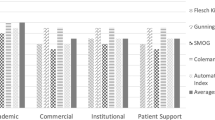Abstract
The Internet is a major source of health information for gynecologic cancer patients. In this study, we systematically explore common Google search terms related to gynecologic cancer and calculate readability of top resulting websites. We used Google AdWords Keyword Planner to generate a list of commonly searched keywords related to gynecologic oncology, which were sorted into five groups (cervical cancer, ovarian cancer, uterine cancer, vulvar cancer, vaginal cancer) using five patient education websites from sgo.org. Each keyword was Google searched to create a list of top websites. The Python programming language (version 3.5.1) was used to describe frequencies of keywords, top-level domains (TLDs), domains, and readability of top websites using four validated formulae. Of the estimated 1,846,950 monthly searches resulting in 62,227 websites, the most common was cancer.org. The most common TLD was *.com. Most websites were above the eighth-grade reading level recommended by the American Medical Association (AMA) and the National Institute of Health (NIH). The SMOG Index was the most reliable formula. The mean grade level readability for all sites using SMOG was 9.4 ± 2.3, with 23.9% of sites falling at or below the eighth-grade reading level. The first ten results for each Google keyword were easiest to read with results beyond the first page of Google being consistently more difficult. Keywords related to gynecologic malignancies are Google-searched frequently. Most websites are difficult to read without a high school education. This knowledge may help gynecologic oncology providers adequately meet the needs of their patients.



Similar content being viewed by others
References
Perrin A, Duggan M (2015) Americans’ Internet access: 2000–2015. Pew Research Center Numbers, Facts and Trends Shaping the World:1–12
Fox S (2011) Health topics. Pew Research Center Pew Internet and American Life Project
Purcell K, Brenner J, Lee R (2012) Search engine use 2012. Pew Research Center Pew Internet and American Life Project (http://pewinternet.org/Reports/2012/Search-Engine-Use-2012.aspx)
Lee K, Kreshnik H, Jeffery H, Lynne E (2014) Dr. Google and the consumer: a qualitative study exploring the navigational needs and online health information-seeking behaviors of consumers with chronic health conditions. J Med Internet Res 16(12):1
Gynecologists, American College of Obstetricians and (2016) Health literacy to promote quality of care. Committee Opinion No. 676. Obstet Gynecol 128:183–186
Friedman DB, Hoffman-Goetz L (2006) A systematic review of readability and comprehension instruments used for print and web-based cancer information. Heal Educ Behav 33(3):352–373. https://doi.org/10.1177/1090198105277329
National Institutes of Health (2007) How to write easy to read health materials. http://www.nlm.nih.gov/medlineplus/etr.html. Accessed 26 March 2017
Ingledew P-A, El-Zammar D, Scali E, Brar B, Lin J (2014) Caught in the web: the quality of online resources for cancer patients. Int J Radiat Oncol 90(1):S604. https://doi.org/10.1016/j.ijrobp.2014.05.1808
Society, American Cancer (2016) Cancer Facts and Figures. http://www.cancer.org/research/cancerfactsstatistics/allcancerfactsfigures/index. Accessed
Baazeem M, Abenhaim H (2014) Google and women’s health-related issues: what does the search engine data reveal? Online J Public Health Informatics 6(2):187
Fu LY, Zook K, Spoehr-Labutta Z, Hu P, Joseph JG (2016) Search engine ranking, quality, and content of web pages that are critical versus noncritical of human papillomavirus vaccine. J Adolesc Health 58(1):33–39. https://doi.org/10.1016/j.jadohealth.2015.09.016
McLeod J, Yu I, Ingledew PA (2016) Peering into the deep: characterizing the Internet search patterns of patients with gynecologic cancers. J Canc Educ 32:85–90
https://adwords.google.com/home/tools/keyword-planner/. Accessed
Kincaid JP, Fishburne RP Jr, Rogers RL, Chissom BS (1975) Derivation of new readability formulas (automated readability index, Fog Count and Flesch Reading Ease Formula) for Navy enlisted personnel. Naval Technical Training Command Millington TN No. RBR-8-75 (Research Branch)
Dale E, Chall JS (1948) A formula for predicting readability: instructions. Educ Res Bull 27(2):37–54
Gunning R (1969) The fog index after twenty years. Int J Bus Commun 6(2):3–13. https://doi.org/10.1177/002194366900600202
Laughlin GHM (1969) SMOG grading-a new readability formula. J Read 12(8):639–646
Team, R Core (2016) R: a language and environment for statistical computing. R Foundation for Statistical Computing, Vienna URL https://www.R-project.org/
Fitzsimmons PR, Michael BD, Hulley JL, Scott GO (2010) A readability assessment of online Parkinson’s disease information. R Coll Physicians Edinburgh 40(4):292–296. https://doi.org/10.4997/JRCPE.2010.401
Freda MC, Damus K, Merkatz IR (1999) Evaluation of the readability of ACOG patient education pamphlets. Obstet Gynecol 93(5):771–774
Schreuders EH, Grobbee EJ, Kuipers EJ, Spaander MCW, Veldhuyzen van Zanten SJO (2017) Variable quality and readability of patient-oriented websites on colorectal cancer screening. Clin Gastroenterol Hepatol 15(1):79–85. https://doi.org/10.1016/j.cgh.2016.06.029
Rosenberg SA, Francis DM, Hullet CR, Morris ZS, Brower JV, Anderson BM, Bradley KA, Bassetti MF, Kimple RJ (2017) Online patient information from radiation oncology departments is too complex for the general population. Pract Radiat Oncol 7:57–62
Azer SA, Alghofaili MM, Alsultan RM, Alrumaih NS (2017) Accuracy and readability of websites on kidney and bladder cancers. J Cancer Educ:1–19
Kamvar M, Baluja S (2006) A large scale study of wireless search behavior: Google Mobile Search. CHI ‘06 Proceedings of the SIGCHI Conference on Human Factors in Computing Systems:701–709
Prevention, United States Department of Health and Human Services. Centers for Disease Control and. 2010. Simply put a guide for creating easy-to-understand materials. Strategic and Proactive Communication Branch 3
Acknowledgements
The following abstract was displayed as a poster during the Western Association of Gynecologic Oncologists (WAGO) 2017 Annual Meeting. All presented WAGO abstracts are published in the October issue of Gynecologic Oncology.
Author information
Authors and Affiliations
Corresponding author
Ethics declarations
Conflict of Interest
The authors have no conflicts of interest to disclose.
Ethics Approval and Consent to participate
The study was reviewed by the University of Louisville Institutional Review Board and deemed exempt from approval, as it does not meet the “Common Rule” definition of human subjects’ research.
Rights and permissions
About this article
Cite this article
Martin, A., Stewart, J.R., Gaskins, J. et al. A Systematic Assessment of Google Search Queries and Readability of Online Gynecologic Oncology Patient Education Materials. J Canc Educ 34, 435–440 (2019). https://doi.org/10.1007/s13187-017-1319-z
Published:
Issue Date:
DOI: https://doi.org/10.1007/s13187-017-1319-z




